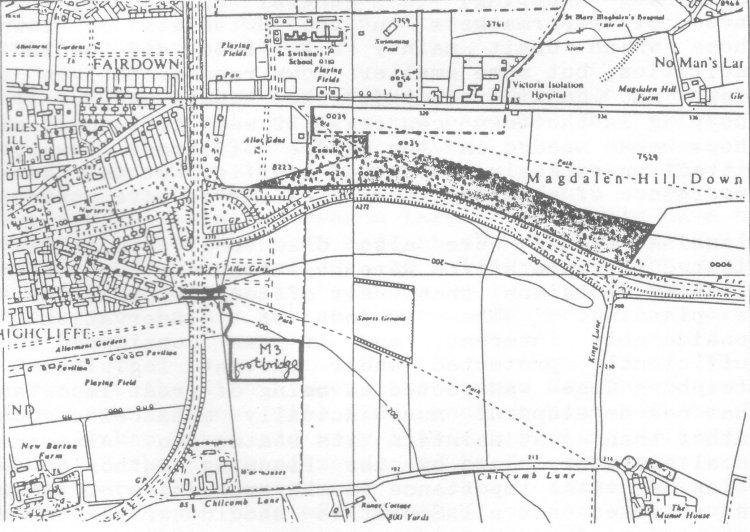

Magdalen Hill Down - TrustNews February 1990
It is strange that Winchester, on its very doorstep, neglects a potentially superb open space, complete with Bronze Age barrows and the spectral outline of the ancient Petersfield/Winchester road. I refer to Magdalen Hill Down, the 23 acres of hillside to the east of the M3 and within easy sauntering distance of a large residential area. Ramparts are - rightly - manned to defend the environs of St Catherine's Hill from M3 desecration. Yet, until now, no one has raised a finger to save its twin, Magdalen Hill Down, from slow death by scrub.
Now, at last, the British Butterfly Conservation Society are coming to the rescue. Fifty years ago, the hillside was open grassland. Grazing by sheep and rabbits favoured fine grasses and flowers, such as orchids and round-headed Rampion. The grazing also maintained an equilibrium between grassland and scrub. When the sheep and rabbits departed, hawthorn and privet gained the upper hand, in places shading the ground flora out of existence. In the surviving pockets of grass, rankness prevails to the detriment of fine grasses and flowers. BBCS plan to turn the clock back 50 years so that all may enjoy the flowers and butterflies again. The Down has never been ploughed or sprayed. Its ancient diversity of specialised plants has, therefore, never been totally destroyed and much will come back once the right conditions have been restored. If nothing is done, the whole hillside will become an impenetrable thicket; and that would be the end of the flowers and butterflies.
During this and next winter, BBCS, using carefully chosen contractors, will cut and burn most of the scrub while retaining selected shelter-belts, thickets and bushes. Virtually the whole of the Down will then be fenced so as to form two sheep-grazing compartments separated by a mid north/south fence. We hope to have sheep grazing in the eastern compartment during autumn 1990, and in the western compartment during autumn 1991. This grazing cycle will be continued, each compartment being grazed for a month or two every other autumn. Openings will be left in the fences and these will be kept open at all times - so as to facilitate public access - except when sheep are actually grazing. Stiles will be provided for all public footpaths.
All this will cost quite a few thousand pounds and BBCS gratefully acknowledge grant-aid from the Nature Conservancy Council and the Hampshire County Council. BBCS also express their thanks to the Church Commissioners and Winchester Bulb Growers, by whose kind coČoperation BBCS are being granted a 20 year lease of the Down.
Of the wide range of grasses on the Down, upright brome predominates. Grass, particularly the finer and softer varieties, is important not just as a setting for flowers but as caterpillar food. Of the 27 butterfly species still found on the Down, the caterpillars of one third feed exclusively on grass. To be acceptable to any particular butterfly species, the grass must be not only the right type for that species but also the right height and in the right condition. Grazing the compartments in alternate years ensures that each butterfly species has a supply of grass of the right height. Modern agricultural ryegrasses are, incidentally, useless to all butterflies.
Even in decline, Magdalen Hill Down is still a magnificent butterfly site. Butterflies love the warmth provided by the steep, concave, south-facing slope, with its massive shelter-belts. Rockrose (foodplant of the brown argus and green hairstreak) and horseshoe vetch (foodplant of the chalkhill blue) are still abundant and support good colonies of all three species. There are vast numbers of the common species: for example, in July, every hardhead seems to sport its marbled white, and sheltered bays are alive with ringlets. Hopefully, BBCS' management will boost existing colonies and even bring back the marsh fritillary and the glorious Adonis blue. Although the foodplants of both these butterflies are still common on the Down, the butterflies themselves departed decades ago. Other sites harbouring these species are too distant to permit natural re-colonisation of the Down, but carefully controlled reintroductions may be possible in the future.
If you want to know more about BBCS, or our plans for Magdalen Hill Down, or our new reserve at Yew Hill, Compton Down (even richer botanically and lepidopterally!) do please contact me, George Yorke, Vice-Chairman, BBCS (Hants Branch), Hughenden, Shawford, Winchester; Tel: 712243.

